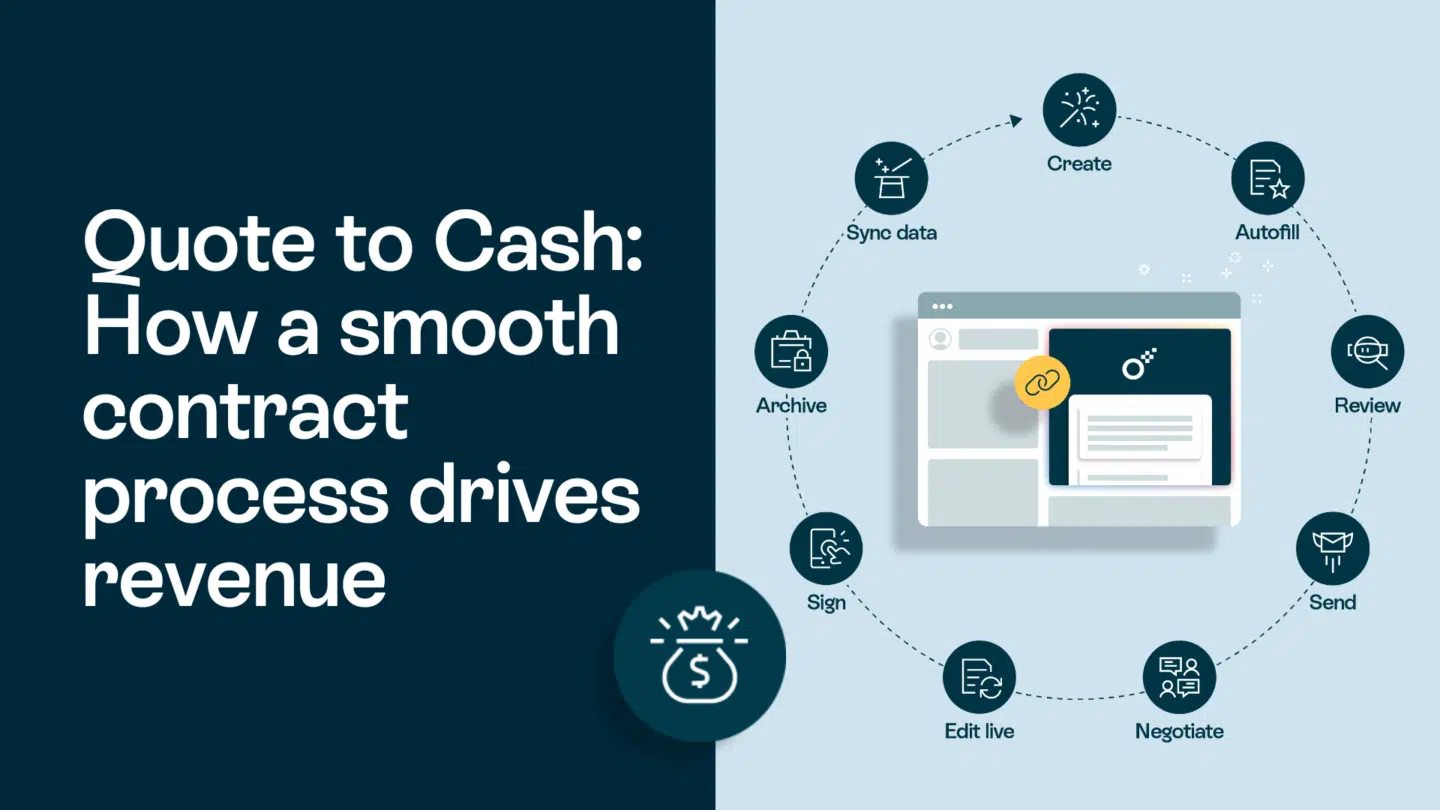
Have you ever missed a contract deadline that cost you penalties and lost opportunities?
For the majority of companies overloaded with documents and contracts, the answer is probably yes.
Don’t worry – the solution is only a few clicks away.
What you need is reliable contract management software to help you organize and manage all your contracts in one place.
There are different types of contract management solutions, some oriented towards a specific industry, while others come with advanced features such as using AI in contract work.
In this article, we’ll dive into all the must-have features to help you choose the best tool for improving your contract management process.
How can contract management software help your business?


Can Oneflow help you save time and money?
Oneflow provides a range of benefits that can help organizations save time and money across the contract lifecycle.
Imagine you’re running a scale-up marketing agency based in Brussels. You’re looking for a remote designer and have found the perfect candidate in Warsaw. You sent the contract through but noticed a mistake. The salary is only displayed in Euros, instead of in both Euros and Polish Złoty.
With the right contract software, you can easily make that change in real time, rather than manually editing and sending the contract back to the signee. Alternatively, you can let the user edit parts of the contract before both parties sign.
This works for businesses of all sizes and in all parts of the world. For example, our client Eurofins found a significant improvement in all their processes when they switched to managing contracts digitally. Managers reported feeling more in control of their employment agreements, leading to better oversight and quicker approvals.
Using contract management platforms comes with three key benefits:
- Saving time – Thanks to automated workflows, the entire contract lifecycle management can run smoothly, from contract drafting to signing. Real-time negotiations can also speed up the closure of deals.
- Reducing business risk – Human errors may occur when handling contracts manually, which leads to expensive legal complications and diminishes trust in business relationships. Automated systems minimize risk by ensuring precision and safety, storing all contracts in a single, easily accessible location.
- Cutting costs – Getting the contract right the first time can significantly enhance your sales. A more efficient process increases success rates and frees up valuable time to chase new business prospects.
To sum it up, efficient contract management helps you increase your ROI, not only in terms of money but also in terms of saved time and improved efficiency.
If you’re not sure where to start, check out our guide to contract creation for some useful tips.
What to look for when choosing contract management software
When you’re deciding what contract management tool you should use, you’re probably wondering what characteristics you should look out for.
Here are a couple of things to consider when evaluating software:
- Ease of use: The tool should be easy to use and understand. Onboarding should be easy and helpful, not hinder your processes.
- Security: Look for a solution with robust security to protect sensitive contract data and be GDPR compliant.
- Features: Choose a platform that has features relevant to your workflows and your industry. For example, some contract management software is tailored for sales teams, while others are made for HR and legal departments.
- AI capabilities: If you want to boost productivity, look for tools with built-in AI to help you automate tasks like contract writing, proofreading and more.
- Cost: Find the right balance between costs and features based on your needs and the size of your business.
- Integrations: The tool should be able to integrate with other systems and applications that you currently use or plan to use.
Keep an eye out for specific features
When selecting a contract management tool, there are some particular features to look for:
- Automation: Automated workflows streamline the contract process, reducing manual errors and saving time and money. Click here to learn what contract automation is and how to get the most out of it.
- Standardized contract templates – Look for contract management software that comes with customizable templates and allows you to create your own.
- Approvals – After setting up your templates and identifying key details, you should be able to create clear approval workflows that fit your business processes.
- Analytics, reporting and search: Readable and easily searchable data provides valuable insights into contract performance and helps organizations make informed decisions.
- Security: The tool should provide robust security to protect sensitive data.
- Integrations: The tool should be able to sync data with other systems and applications, from CRM to HRM and project management systems. Click here to discover all the types of integrations you might need.
Improve your contract management process: Cloud-based vs. offline solutions
Instead of handling everything manually, using contract automation software is definitely better. However, not all contract management systems are created equal.
We’ll now briefly compare cloud-based and offline solutions and explain the differences between the two.
Cloud-based solutions can be accessed from the browser, while offline software needs to be installed on a device.
Here are some reasons to opt for cloud-based solutions for managing digital contracts:
- Live editing – Cloud software allows multiple people to collaborate and edit contracts in real time. This means that everyone is looking at the most current contract version, and there’s no need to send contracts back-and-forth via email.
- Real-time negotiation – You can leave comments directly on the contract if you want to ask questions or suggest changes. The other party sees them immediately, making communication clear and direct.
- Unlimited storage – Cloud solutions don’t take up space on your device and often offer unlimited contract storage. Therefore, you don’t have to worry about your contracting tools running out of space over time.
- Remote access – Access a cloud-based contract management system from anywhere and on any device, making it perfect for remote and hybrid companies.
- Enhanced security – Cloud-based solutions are safer than offline solutions as they often offer robust data encryption, automatic backups and controlled access. This can reduce the risk of data loss and unauthorized access.
Keep reading to discover the best contract management tools we’ve gathered and tested for you.
Top 10 contract management software options
Oneflow

Oneflow is a leading contract automation software with a comprehensive feature set for managing contract workflows. With Oneflow, you can create, manage and track contracts effortlessly.
The platform lets you customize contract templates, collaborate in real time, and even e-sign contracts securely. It comes with an intuitive contract template builder to help you draft anything from service contracts and agreements to proposals and other business documents for all industries.
Oneflow also offers analytics and detailed reporting tools to gain insights into your contract performance such as visits, opens and other important KPIs.
Oneflow helps you with the whole contract lifecycle management including pre- and post-sign processes. Pre-sign processes include drafting and approving your contract. Our AI features save you a significant amount of time by helping you generate contract drafts that comply with all regulations and have all the necessary elements.
You can also create automated approval workflows and even lock them to a template. There’s also the option to automatically send contracts for signing after they have been approved, significantly reducing repetitive work.
Once the contract is sent, there’s no need to check anything manually. You’ll get a notification when the other party opens the document for the first time and when they sign it. Also, you can easily track all the changes in a document using our audit trail feature.
Also, our tool includes a built-in AI assistant that can automatically review your contracts, mitigate risks and provide recommendations for improvements.
Features
- AI assistant
- Large template library
- Real-time collaboration
- E-signatures
- Two-step authentication
Pricing
- Free plan: Forever free plan includes PDF contracts, comments, audit trails and dashboards, plus 14-day access to Premium features, with no credit card required
- Essentials: $17/user/month, includes digital contracts, templates and integrations
- Business: $45/user/month, includes data fields, tags, contract lifecycle management and premium integrations
- Enterprise: Custom price upon request, includes shared templates, single sign-on (SSO) and SCIM API
User rating
- G2: 4.5
- Capterra: 4.5
DocuSign

DocuSign is a contract management software tool that facilitates managing the entire contract lifecycle, from creation to signing, contract execution and storage.
The software offers a user-friendly interface. DocuSign also integrates with other platforms, such as Salesforce and Microsoft Office.
With its industry-leading security measures and compliance certifications, DocuSign ensures that contracts are safe and legally binding. Plus, its analytics and reporting features give you valuable insights into your contract performance.
If you want to learn more, here’s how DocuSign compares with some other tools:
Features
- Automated document generation
- Electronic notarization
- Offline signing
- Document encryption
- Bulk sending
Pricing
- Standard: $35/user/month, including one custom workflow
- Professional: $65/user/month, including 10 custom workflows, SSO and bulk sending
- Enterprise: Custom price upon request, including SMS and phone authentication
However, bear in mind that every plan comes with a limited number of envelopes, with a maximum of 100 envelopes per year. You can purchase additional envelopes, but the price adds up quickly if you have a lot of contracts. That’s why you may want to check out DocuSign alternatives.
User rating
- G2: 4.5
- Capterra: 4.8
PandaDoc

PandaDoc is a document automation software mostly used by HR teams. It offers a range of features, including contract creation, collaboration, e-signatures and even payment collection.
PandaDoc’s intuitive interface and drag-and-drop editor allow you to create contracts without technical skills. It integrates with various CRM and payment platforms, allowing you to automate your workflows.
Additionally, PandaDoc has analytics and reporting tools to help you track your contract performance and identify areas for improvement. If you want to see how it compares with some other PandaDoc alternatives, check out these articles:
Features
- Drag-and-drop editor
- Workflow automation
- Reporting and analytics
- Deal rooms
- Smart content
Pricing
- Starter: $35/user/month, includes unlimited document uploads and e-signatures
- Business: $65/user/month, includes custom branding, content library, and CRM integrations
- Enterprise: Custom price available upon request, includes workflow automation, SSO and API
You can get up to 46% discount by opting for annual payments.
User rating
- G2: 4.7
- Capterra: 4.5
GetAccept

GetAccept is contract management software that focuses on sales enablement and document tracking. It includes features like document creation, e-signatures and sales automation tools.
With GetAccept, you can personalize your contracts, track recipient activities and schedule automated follow-ups. The software also includes AI capabilities that predict your contract success rate through an automated engagement scoring system.
This tool integrates with CRM and sales platforms such as Salesforce, HubSpot and Pipedrive. It also provides insights to help you understand your contract performance and optimize your sales strategy.
Features
- Contract library
- Electronic signatures
- Sales automation
- Configure Price Quote (CPQ)
- Notifications and reminders
Pricing
You can purchase different feature sets separately:
- Electronic signature: $25/user/month
- Deal room: $39/user/month, a space for sales and contract negotiations
- Contract room: $49/user/month, a space for creating contracts and proposals
or get a Full Suite for $79/user/month.
All plans can be adjusted for enterprises at a custom price.
User rating
- G2: 4.6
- Capterra: 4.6
Dropbox Sign (formerly HelloSign)

HelloSign is one of the most popular e-signature platforms. It was acquired by Dropbox in 2019. Even though it changed its name to Dropbox Sign, most key features remained the same.
It’s a simple and user-friendly software that allows you to create, sign and send contracts. The tool offers a clean and intuitive interface, making it easy to navigate and manage your contracts. Dropbox Sign integrates with popular cloud storage platforms, such as Google Drive and Dropbox.
In addition to its contract management features, Dropbox Sign comes with plenty of templates, team management tools and advanced security measures.
See also: Best alternatives to Dropbox Sign (HelloSign)
Features
- eSignatures
- Reusable templates
- Document tracking
- Qualified electronic signatures (QES)
- Integration with Dropbox tools
Pricing
- Essentials: $20/month, only one user seat, unlimited signing and five templates
- Standard: $30/user/month, with 15 templates
- Premium: Custom price upon request, includes unlimited templates and advanced reporting and analytics
You can get a discount by opting for annual payments.
User rating
- G2: 4.7
- Capterra: 4.7
ContractSafe

ContractSafe is a cloud-based contract management software for businesses of all sizes. It lets you securely store and manage your contracts in one centralized location. The software has advanced search capabilities for finding specific contracts or clauses. ContractSafe also provides customizable workflows, reminders, and alerts that ensure you never miss contract deadlines.
With its user-friendly interface and strong security measures, ContractSafe could be a good option for those looking to mitigate risks and avoid data breaches.
Features
- Advanced search capabilities
- Notifications and reminders
- Secure contract repository
- Control over user roles
- AI assistant
Pricing
All plans include unlimited users. The price is based on the number of contracts you’re managing. You can calculate the exact cost on the ContractSafe website. Here are the starting prices for less than 100 contracts:
- Organize: Starting at $450 per month, only basic features
- Finalize: Starting at $695 per month with e-signature, single sign-on and integration with Zapier
- Maximize: Starting at $895 per month with templates, APIs and Salesforce integration
You can get a discount by opting for annual payments.
User rating
- G2: 4.6
- Capterra: 4.8
Juro

With Juro, you can create and edit contracts collaboratively in real time. The software offers a range of contract templates and extensive customization options, making it easy to create professional contracts quickly. It also comes with contract approval workflows and e-signatures.
It’s also a data visualization software that helps you understand your contract performance. You can use Juro’s AI to create contract drafts, revise and refine clauses and scan documents for potential risks.
Features
- Juro AI
- Contract creation
- Advanced customization
- Contract analytics with data visualization
Pricing
All pricing plans are custom, with prices available upon request. You can build your plan by choosing the features, integrations and level of customer support you need. However, according to online sources, it’s on the pricier side, so if you’re looking for something more affordable, you may want to check the best alternatives to Juro.
User rating
- G2: 4.6
- Capterra: 4.7
Scrive

Scrive is a simple yet user-friendly tool with three main purposes: creating e-signatures and eIDs and building web forms. It’s tailored for the European market, and it’s compliant with all its security regulations, such as GDPR and eIDAS.
You can use its web form builder to create different types of documents, including HR and legal documents, payment authorizations and forms for collecting data from a large volume of users.
However, it has fewer templates than other tools on our list, and they’re only included in the pricier plans. If you’re looking for a tool with plenty of templates, make sure to check out the 10 best Scrive alternatives.
Features
- Mobile contract signing
- Detailed audit trails
- Document branding
- eSignatures
- eID
Pricing
Scrive is a European company which is why they express prices in euros. Only pricing for e-signature is available online. There are three plans:
- Essential: €18/user/month, with unlimited signing, audit trail and document review tracking
- Business: €39/user/month, with custom branding, templates, plugins and integrations
- Enterprise: Custom price upon request, enterprise-level security
Scrive also offers some other plans, such as eSign forms and eID club, that can either be purchased as add-ons or separately, but their pricing is available only upon request.
User rating
- G2: 4.7
- Capterra: 5
Adobe Sign

Adobe Sign is an e-sign software designed for Adobe users. It comes with pre-made integrations with other tools from the Adobe family. It’s limited to signing documents and creating simple web forms, but its integration with Adobe Document Cloud allows you to store and manage all your documents securely.
Apart from Adobe, it also integrates with Microsoft Office and Salesforce. It stands out for its customizable branding features and bulk sending documents to many recipients. It also comes with detailed analytics and reporting tools that let you track changes in the progress of your contract.
However, the initial setup is a bit tricky, especially if you’re not an Adobe user already. If you need a quick solution, you may want to check out the best Adobe Sign alternatives.
Features
- Electronic signatures
- Document tracking
- Automatic record-keeping
- Customizable workflows
- Web form creation
Pricing
Adobe Sign is included in the following Acrobat plans:
For individuals:
- Acrobat Standard: $22.99/month, includes signing documents and editing PDFs
- Acrobat Pro: $29.99/month, includes custom branding and creating web forms
For companies:
- Acrobat Standard for teams: $14.99/user/month
- Acrobat Pro for teams: $23.99/user/month
- Acrobat Sign Solutions: Custom price upon request; it can include industry-specific compliance such as HIPAA
You can get a discount by opting for annual payments.
User rating
- G2: 4.4
- Capterra: 4.6
SignNow

Last but not least, SignNow is a contract management software that focuses on simplicity and ease of use. The software offers a user-friendly interface and intuitive signing experience, making it easy for both you and your clients to complete the signing process.
That’s why it’s often used for in-person signing when you need to collect a lot of e-signs quickly. It has a mobile app that allows you to turn your mobile phone into an electronic kiosk to collect in-person signatures.
Regarding documents, it can be a good option for creating and storing medical records as it’s HIPPA compliant. It has plenty of templates that allow you to add custom fields and collaborate on document creation in real time.
Features
- Electronic signatures
- Contract templates
- Real-time collaboration
- Bulk signing
- Security and authentication
Pricing
- Business: $20/user/month, with unlimited templates
- Business Premium: $30/user/month, with bulk sending and payment requests
- Enterprise: $50/user/month, with smart fields and advanced threat protection
You can get up to 60% discount by opting for annual payments.
User rating
- G2: 4.6
- Capterra: 4.6
The best contract management software: Comparison table
| Software | Key features | Pricing | Best for |
| Oneflow | AI assistant Large template library Real-time collaboration E-signatures Two-step authentication | Forever free plan From $17/user/month | Contract automation throughout the whole contract management lifecycle |
| DocuSign | Automated document generation Electronic notarization Offline signing Document encryption Bulk-sending | From $35/user/month | Signing and notarizing documents online |
| PandaDoc | Drag-and-drop editor Workflow automation Reporting and analytics Deal rooms Smart content | From $35/user/month | Sales teams negotiating contracts |
| GetAccept | Contract library Electronic signatures Sales automation Configure Price Quote (CPQ) | From $25/user/month | Sales teams who want to track their documents |
| Dropbox Sign | eSignatures Reusable templates Document tracking Qualified electronic signatures (QES) Integration with Dropbox tools | From $20/month for individual users and $30/user/month for teams and companies | Companies that are already using Dropbox tools |
| ContractSafe | Advanced search capabilities Secure content repository Full control over user roles Active security and data protection | From $450/month | Companies with a lot of documents that need to be able to search for information quickly |
| Juro | Juro AI Contract creation Advanced customization Contract analytics and data visualization | N/A | Companies looking for a tool with good data visualization tools |
| Scrive | Mobile signing Detailed audit trails Document branding SignatureeID | From €18/user/month | Companies looking for a tool with multiple options for eSignature and eID |
| Adobe Sign | Electronic signature Document tracking Automatic record-keeping Customizable workflows Web form creation | From $22.99/month for individual users and $14.99/user/month for teams | Adobe users |
| SignNow | Electronic signatures Contract templates Real-time collaboration Bulk signing Security and authentication | From $20/user/month | Companies that need to bulk-sign a lot of documents |
Conclusion
Switching to digital contract management tools can significantly boost your efficiency, save you time and reduce costly mistakes. It not only boosts your productivity, but it can also lead to increased profit.
However, it’s essential to choose a reliable tool with the right balance of features and cost.
Oneflow can be the right solution for you, as it allows you to create contracts quickly and collaborate on them in real time. Our AI assistant speeds up the writing process and reviews the contracts for you.
What’s more, you can get many of our features for free, with a 14-day free access to paid features as well. Sign up for free today.
FAQs
What is a contract management software?
A contract management solution is used to store, organize, and manage existing contracts. Its key features include contract storage, tracking and alerts for contract renewal or expiration.
What is the difference between CRM and contract management?
CRM stands for customer relationship management; it focuses on managing customer interactions across all touchpoints, tracking leads and building relationships that lead to sales. Contract management refers to tracking contracts, agreements and proposals.
What is CLM in software?
CLM stands for contract lifecycle management. Such software streamlines the whole contracting process throughout all its key stages. Those phases include the contract creation process, authorization, negotiation and approval, contract signing and renewal.
Can DocuSign be used for contract management?
Yes, DocuSign is a contract management platform, but it may not be the best solution for everyone. It uses a unique envelope-based pricing system where the price can quickly add up. It also has limitations regarding the file size that can be uploaded and the integrations you can use. Therefore, we suggest checking out these DocuSign alternatives.








